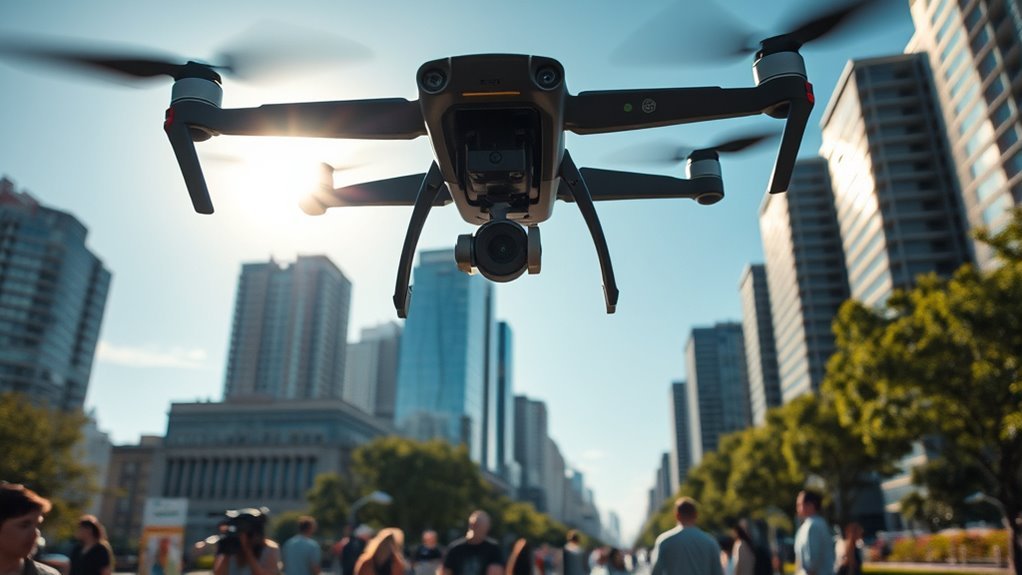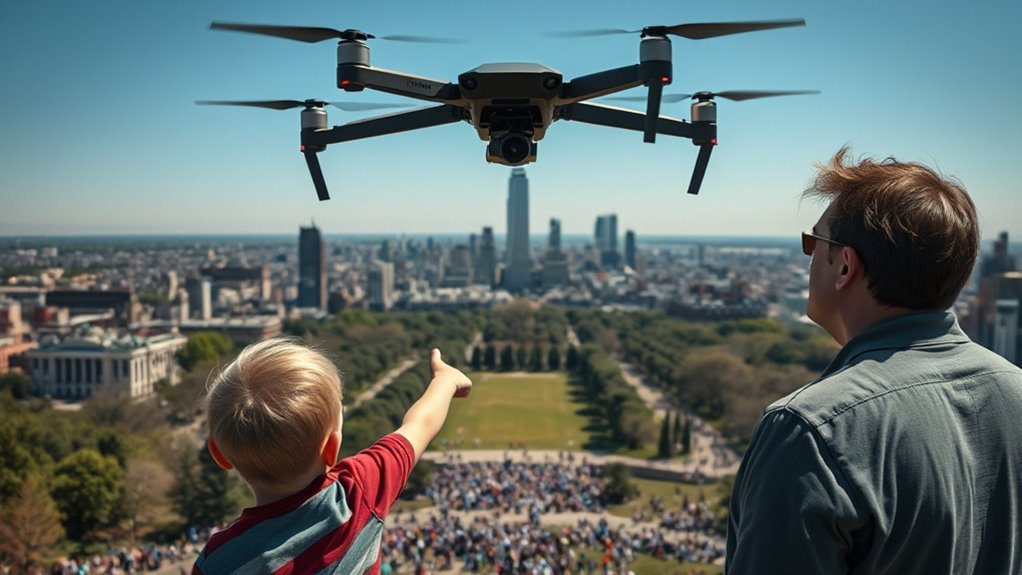Drones present various real threats, including invasion of privacy, safety issues, and potential misuse. They can capture data without consent, leading to unauthorized surveillance. Regulatory frameworks struggle to keep up, creating enforcement challenges. Safety risks arise from pilot error and equipment failure. Additionally, drones may be weaponized or hacked for malicious purposes. Their operation can disturb wildlife, altering habits and migration patterns. Understanding these risks is essential, and there’s more to explore on how to mitigate them.
Invasion of Privacy

How often do we consider the implications of drones hovering above our private spaces? The rise of drone surveillance poses significant risks to personal boundaries. These unmanned aerial vehicles can easily penetrate areas once deemed secure, capturing images and data without consent. This invasion of privacy challenges our fundamental rights, as individuals find their actions scrutinized without their knowledge. The technology’s accessibility means that almost anyone can deploy drones, raising concerns about malicious intent and misuse. As you navigate your daily life, it’s essential to recognize the potential for unauthorized observation and the erosion of personal space. Safeguarding your privacy in this era of drone surveillance requires vigilance and a proactive approach to maintaining your autonomy against encroaching technologies.
Regulatory Challenges

As drone technology advances, regulatory frameworks struggle to keep pace with the rapid evolution of the industry. You’re likely to encounter significant airspace management issues and heightened privacy and surveillance concerns that complicate enforcement. Understanding these regulatory challenges is essential for maneuvering the complexities of drone operation and ensuring compliance. Moreover, the balance between personal freedom and federal oversight remains a critical aspect of addressing these challenges. Additionally, the integration of real-time information streams could enhance regulatory compliance by providing up-to-date data on drone operations and activities.
Evolving Legal Frameworks
While drones offer significant advancements in various fields, their rapid proliferation presents complex regulatory challenges that governments must navigate. The evolving legal frameworks surrounding drone usage raise numerous legal implications, necessitating robust policy development.
Here’s a concise overview of the key considerations:
| Legal Considerations | Policy Development |
|---|---|
| Privacy concerns | Establishing guidelines |
| Airspace usage rights | Balancing innovation |
| Liability issues | Ensuring public safety |
As you ponder these aspects, recognize that without a coherent legal framework, the potential benefits of drones could be overshadowed by misuse and public apprehension. Striking a balance between freedom and regulation is essential for fostering innovation while protecting individual rights.
Airspace Management Issues
The complexities of airspace management become increasingly apparent as drone usage expands in both urban and rural environments. You’ll find that effective airspace coordination is vital for integrating drones into existing air traffic systems. As these devices proliferate, regulatory bodies face the challenge of ensuring safe operations without stifling innovation. Airspace management must adapt, establishing clear guidelines to prevent conflicts between traditional aircraft and drones. Issues arise around altitude restrictions and designated flight paths, complicating compliance. Furthermore, the lack of a unified framework can lead to confusion among operators and air traffic controllers alike. Addressing these regulatory challenges is essential to foster a safe, efficient, and autonomous aerial landscape, enabling the freedom to innovate while prioritizing safety.
Privacy and Surveillance Concerns
With the rise of drone technology, privacy and surveillance concerns have become increasingly prominent, necessitating a careful examination of regulatory challenges. Drones enable extensive data collection, often without individuals’ consent, leading to heightened fears about unauthorized surveillance. As you navigate this landscape, consider how existing laws struggle to keep pace with rapidly evolving drone capabilities. The public perception of drones is largely shaped by these privacy issues, potentially fostering distrust and resistance toward their use. Effective regulations must balance innovation with the protection of personal freedoms, ensuring that drone activity doesn’t infringe on your right to privacy. Addressing these concerns is vital to fostering a society where technology serves freedom rather than encroaching upon it.
Safety Risks and Accidents

As drone usage continues to expand across various sectors, understanding the safety risks and potential for accidents becomes increasingly critical. You’re likely aware that pilot error is one of the primary causes of drone incidents. Misjudgments in piloting can lead to crashes, endangering both operators and bystanders. Additionally, equipment failure poses a significant risk; mechanical issues or software glitches can result in loss of control. Ensuring that drones are regularly maintained and equipped with fail-safes is essential to mitigate these dangers. For instance, cold temperatures can significantly impact battery life and performance, potentially leading to unexpected failures during flight. As you navigate the sky, recognizing these risks can empower you to make informed decisions, enhancing safety for yourself and others. Awareness and proactive measures can help balance technological freedom with responsible drone use. Regular inspections can help identify parts needing attention before they lead to potential failures.
Security Threats and Surveillance
While drone technology offers innovative solutions in various fields, it also introduces significant security threats, particularly in the domain of surveillance. Unregulated aerial monitoring can lead to unauthorized data collection, infringing on personal privacy and civil liberties. As drones become more accessible, the risk of misuse escalates, allowing individuals or organizations to conduct intrusive surveillance without consent. Understanding drone surveillance mechanisms empowers advocacy for effective countermeasures against these threats. Additionally, the potential for real-time disease outbreak monitoring using drones highlights the dual-edged nature of this technology, as it can be applied for both public health benefits and invasive surveillance practices.
| Threat Type | Description | Potential Impact |
|---|---|---|
| Unauthorized Access | Drones capturing private data | Violation of privacy |
| State Surveillance | Government monitoring citizens | Erosion of freedom |
| Criminal Activity | Drones used for illicit purposes | Increased security risks |
Addressing these threats requires robust regulations to safeguard individual rights while balancing technological advancements.
Wildlife Disturbance
Drones can greatly disrupt wildlife, particularly during critical nesting periods when disturbances can lead to abandonment of nests. The presence of drones induces stress in various species, impacting their behavior and overall health. Additionally, habitat fragmentation caused by drone activity may alter migration patterns and reduce biodiversity.
Nesting Disruption
The increasing presence of drones in natural habitats poses a significant threat to wildlife, particularly during critical nesting periods. Drone interference can disrupt established nesting patterns, leading to abandonment of nests. When drones fly too close, they can cause adult birds to flee, leaving eggs or chicks vulnerable to predators and environmental stressors. This disruption not only threatens immediate survival but can also alter long-term reproductive success. Additionally, the noise and movement associated with drones may deter wildlife from using previously suitable nesting sites. As drone technology becomes more accessible, understanding the implications of nesting disruption is essential for conservation efforts and wildlife management. It’s crucial to balance technological freedom with the preservation of biodiversity.
Stress on Wildlife
Nesting disruption is just one aspect of a broader concern regarding wildlife disturbance caused by drone activity. These interactions can considerably alter wildlife behavior, affecting feeding, mating, and migration patterns. Understanding the impact of drone usage on wildlife is essential for mitigating these risks.
| Type of Wildlife | Affected Behavior |
|---|---|
| Birds | Increased stress, reduced nesting success |
| Mammals | Altered foraging habits, increased flight distance |
| Reptiles | Disruption in basking and nesting activities |
As you engage with drone technology, consider the implications of your actions on local ecosystems. Responsible drone operation can help preserve the delicate balance of wildlife interactions, ensuring freedom for both you and the creatures inhabiting these environments.
Habitat Fragmentation
While it may seem harmless to operate a drone in natural areas, the reality is that such activities can lead to significant habitat fragmentation. When drones invade wildlife habitats, they disrupt animal behaviors and migration patterns, contributing to habitat loss. This disruption can isolate species, severing their connections to essential resources, which ultimately destabilizes ecosystem balance. As wildlife becomes more fragmented, the genetic diversity necessary for resilience diminishes, making populations more vulnerable to environmental changes. You might enjoy the freedom of flying a drone, but it’s vital to recognize the broader implications of your actions. By understanding the potential for habitat fragmentation, you can make more informed decisions that protect both your recreational interests and the delicate ecosystems we depend on.
Misuse by Malicious Actors
As drones become increasingly accessible and affordable, the potential for misuse by malicious actors escalates considerably. You should be aware of the various forms of malicious usage, including drone hacking. This can lead to significant security threats, impacting both privacy and public safety. Strict regulations are in place to mitigate these risks, underscoring the importance of handling drone-related issues responsibly. Shooting down a drone can lead to serious legal consequences, which underscores the importance of handling drone-related issues responsibly.
| Type of Misuse | Description |
|---|---|
| Drone Hacking | Unauthorized access to drone controls, leading to hijacking. |
| Surveillance | Invasive monitoring of private spaces without consent. |
| Weaponization | Equipping drones for attacks or harassment. |
| Smuggling | Transporting illegal goods across borders. |
| Disruption | Interfering with critical infrastructure like airports. |
Understanding these risks is essential for protecting your freedoms while maneuvering through the evolving landscape of drone technology.
Frequently Asked Questions
How Do Drones Impact Local Businesses and Job Markets?
Like a double-edged sword, drones reshape local businesses and job markets. They enhance delivery services but raise surveillance concerns, potentially leading to job displacement while creating new opportunities in tech and logistics sectors.
What Are the Environmental Effects of Drone Usage?
Drones can contribute to drone pollution, affecting air quality and wildlife. Their noise and presence may lead to ecosystem disruption, impacting habitats and species. Understanding these effects is essential for mitigating potential environmental harm and preserving freedom in our surroundings.
Can Drones Contribute to Emergency Response Efforts?
Yes, drones can greatly enhance emergency response efforts. Their drone surveillance capabilities allow for real-time data collection, facilitating disaster recovery by identifying affected areas and delivering supplies quickly, ultimately improving efficiency and saving lives during crises.
How Do Drones Affect Air Traffic Management Systems?
Drones can exacerbate airspace congestion, complicating air traffic management. You’ll face regulatory challenges as authorities struggle to integrate these unmanned vehicles safely, balancing innovation with ensuring the safety and efficiency of shared airspace.
What Are the Psychological Effects of Drones on Communities?
Drones can induce anxiety in communities, fostering a sense of surveillance that erodes trust. This persistent observation may lead to feelings of vulnerability, impacting social cohesion and individual freedoms, ultimately altering how you perceive safety and privacy.

